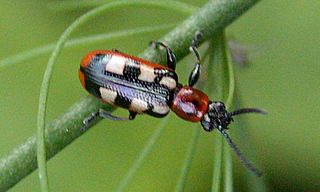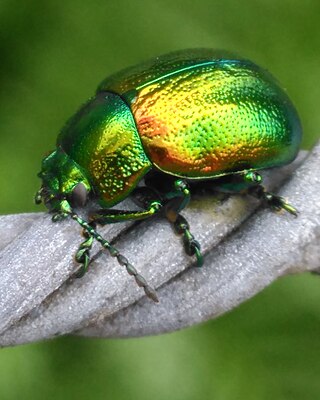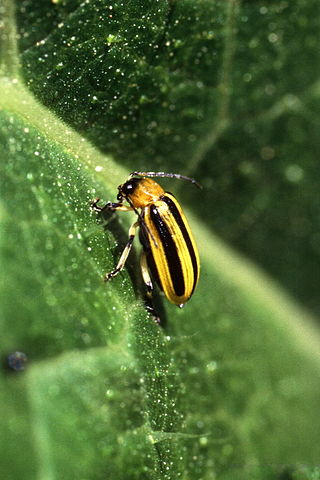
The Colorado potato beetle is also known as the Colorado beetle, the ten-striped spearman, the ten-lined potato beetle, or the potato bug. It is a major pest of potato crops. It is about 10 mm long, with a bright yellow/orange body and five bold brown stripes along the length of each of its elytra. Native to the Rocky Mountains, it spread rapidly in potato crops across America and then Europe from 1859 onwards.

The insects of the beetle family Chrysomelidae are commonly known as leaf beetles, and include over 37,000 species in more than 2,500 genera, making up one of the largest and most commonly encountered of all beetle families. Numerous subfamilies are recognized, but the precise taxonomy and systematics are likely to change with ongoing research.

The common asparagus beetle is an important pest of asparagus crops both in Europe and in North America. Asparagus is its only food plant. The beetle is 6.0 mm to 9.5 mm long and slightly elongated. It is metallic blue-black in color with cream or yellow spots on its red-bordered elytra. The larvae are fat gray grubs with dark heads.

The tansy beetle is a species of leaf beetle. The common name derives from its main foodplant, Tansy, but it can also use other wetland plants such as Gypsywort and Water Mint. It measures 7.7–10.5 mm in length and has a characteristic bright metallic green colouration, with pitted elytra and a coppery tinge. In addition to the nominotypical subspecies, which repeats the specific name, C. graminis graminis, there are five further distinct subspecies of Tansy beetle, which, collectively, have a Palearctic distribution, although in the majority of countries where it is found the species is declining. In the United Kingdom it is designated as 'Nationally Rare'. The stronghold population here is located along the banks of the river Ouse in York, North Yorkshire. Other, small, fenland populations exist at Woodwalton Fen and at Welney Wildfowl and Wetlands Trust (WWT) reserve.

The noble chafer is a species of beetles belonging to the family Scarabaeidae, subfamily Cetoniinae.

Acalymma vittatum, the striped cucumber beetle, is a beetle of the family Chrysomelidae and a serious pest of cucurbit crops in both larval and adult stages. The striped cucumber beetle has a distinctive appearance, displaying a yellow-colored elytra with black stripes. It is distributed from eastern North America to the Rocky Mountains and can be found as far south as Mexico and as far North as southern Canada. In western North America, past the Rocky Mountains, the striped cucumber beetle is replaced by Acalymma trivittatum, a duller colored species often with grayish or pale white elytra rather than yellow.

Pyrochroa coccinea, commonly known as the black-headed cardinal beetle, is a species of cardinal beetle in the family Pyrochoidae. It is found mainly in wooded areas and pastures throughout central Europe, including southern Great Britain. Similar to other species of Ambrosia beetles, P. coccinea live and reproduce on wooden logs in early stages of decomposition. Larvae develop over the span of many years, with overlapping generations often inhabiting a single wooden territory. Adults, however, are short-lived and exist during a brief season. They typically show up in April, become more populous in May and early June, and become very rare in the remaining months.

Chrysolina cerealis, the rainbow leaf beetle or Snowdon beetle, is a beetle belonging to the family Chrysomelidae.

Xanthogaleruca luteola, commonly known as the elm-leaf beetle, is a beetle species in the family Chrysomelidae that is native to Europe but invasive in other parts of the world.

The leaf beetle Chrysomela lapponica is found in central and northern Europe feeding on leaves of willows and birch. The adult beetles are about 8 mm long and beetles in different regions can have different colour patterns on their elytra.

Pachyta quadrimaculata is a species of the Lepturinae subfamily in long-horned beetle family.

Arima marginata is a species of leaf beetles of the subfamily Galerucinae in the family Chrysomelidae.

Chrysomela populi is a species of broad-shouldered leaf beetle belonging to the family Chrysomelidae, subfamily Chrysomelinae.

Crioceris duodecimpunctata or the spotted asparagus beetle is a species of shining leaf beetle belonging to the family Chrysomelidae, subfamily Criocerinae.

Lachnaia italica is a species of short-horned leaf beetles belonging to the family Chrysomelidae, subfamily Clytrinae.

Lilioceris merdigera is a species of beetle belonging to the family Chrysomelidae, subfamily Criocerinae.

Cerotoma trifurcata is a species of beetle in the Chrysomelidae family that can be found in the Eastern and West United States.

The sumac flea beetle, Blepharida rhois, is most commonly found in North America and is a member of the herbivorous beetle family, Chrysomelidae. More specifically, this beetle is part of the Alticinae subfamily, a highly diverse subfamily that includes more than 1000 species in 550 genera. Members of the Chrysomelidae family are distinguished by their enlarged metafemora and their ability to jump up to 100 times their length. This gives the beetle the ability to catapult jump in order to escape approaching predators. This ability has led to the common name of “flea beetle.” Both larvae and adults are typically a quarter of an inch long. While adults are cream colored with irregular reddish patterns, larvae are typically gray with yellow stripes.

Cryptocephalus trimaculatus is a species of cylindrical leaf beetle belonging to the family Chrysomelidae, subfamily Cryptocephalinae.
Alois M. Huger was a German entomologist and a pioneer in insect pathology as well as in the use of insect pathogens for the biological control of pest insects. He worked mainly on the diagnosis of insect diseases in Darmstadt, Germany. Among others, he discovered a virus disease of the coconut palm rhinoceros beetle in Malaysia from a previously unknown group of viruses which provided long-term control of this pest when introduced into islands invaded by the beetle.




















